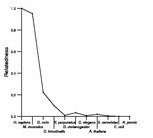
| Name: KCNMB4 | Sequence: fasta or formatted (210aa) | NCBI GI: 26051275 | |
|
Description: calcium-activated potassium channel beta 4 subunit
|
Referenced in:
| ||
|
Composition:

Amino acid Percentage Count Longest homopolymer A alanine 5.7 12 1 C cysteine 5.2 11 1 D aspartate 3.8 8 2 E glutamate 6.2 13 1 F phenylalanine 5.2 11 1 G glycine 3.8 8 1 H histidine 2.9 6 1 I isoleucine 4.8 10 2 K lysine 5.2 11 2 L leucine 11.0 23 2 M methionine 1.4 3 1 N asparagine 4.3 9 2 P proline 3.8 8 2 Q glutamine 6.2 13 2 R arginine 3.8 8 1 S serine 7.1 15 1 T threonine 5.2 11 1 V valine 9.0 19 2 W tryptophan 1.9 4 1 Y tyrosine 3.3 7 1 |
Comparative genomics:
Search single species RefSeq proteins at NCBI
Search summary 
Figure data | ||
Related human proteins:Protein Relative score Description Self-match 1.000 calcium-activated potassium channel beta 4 subunit [... KCNMB3 0.277 calcium-activated potassium channel beta 3 subunit i... KCNMB3 0.277 calcium-activated potassium channel beta 3 subunit i... KCNMB3 0.277 calcium-activated potassium channel beta 3 subunit i... KCNMB3 0.277 calcium-activated potassium channel beta 3 subunit i... KCNMB2 0.235 calcium-activated potassium channel beta 2 subunit [... KCNMB2 0.235 calcium-activated potassium channel beta 2 subunit [H... KCNMB1 0.058 potassium large conductance calcium-activated channel... CASP8AP2 0.015 caspase 8 associated protein 2 CASP8AP2 0.015 caspase 8 associated protein 2 CASP8AP2 0.015 caspase 8 associated protein 2 MUC5AC 0.010 mucin 5AC ZNF840 0.010 PREDICTED: zinc finger protein 840 ZNF840 0.010 PREDICTED: zinc finger protein 840 ZNF840 0.010 PREDICTED: zinc finger protein 840 MUC5B 0.010 mucin 5, subtype B, tracheobronchial C7orf63 0.007 hypothetical protein LOC79846 isoform 2 C7orf63 0.007 hypothetical protein LOC79846 isoform 1 TSC1 0.007 tuberous sclerosis 1 protein isoform 1 TSC1 0.007 tuberous sclerosis 1 protein isoform 4 TSC1 0.007 tuberous sclerosis 1 protein isoform 3 C14orf115 0.007 hypothetical protein LOC55237 ITPR1 0.005 inositol 1,4,5-triphosphate receptor, type 1 isofor... ITPR1 0.005 inositol 1,4,5-triphosphate receptor, type 1 isofor... UTS2R 0.005 urotensin 2 receptor SARM1 0.005 sterile alpha and TIR motif containing 1Human BLASTP results (used to prepare the table) | |||
Gene descriptions are from NCBI RefSeq. Search results were obtained with NCBI BLAST and RefSeq entries. When identical proteins are present, the self-match may not be listed first in BLASTP output. In such cases, the table above has been reordered to place it first.
See About the Figures for the scoring system used in the figure above right. The same scoring system was used in the table of BLASTP results.
Guide to the Human Genome
Copyright © 2010 by Stewart Scherer. All rights reserved.
